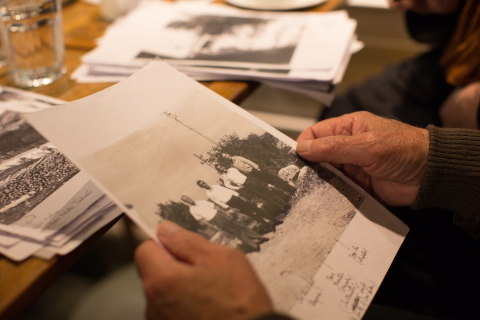
The origins of the Istro-Romanian community are controversial, but it probably descends from pastoral communities originally resident in Bosnia, Serbia, and Croatia in the Middle Ages, who began to settle in Istria from the late Middle Ages. The community seems to have established itself in its present region - which in the nineteenth century also included the Adriatic islands of Krk and Rab - in response to the Turkish invasions of the late fifteenth and early sixteenth centuries. Istria at that time was under Venetian domination, and Venice apparently encouraged repopulation of the region, which had earlier been severely depopulated by plague in the fifteenth century.
Historical documents show that Istro-Romanian was widely spoken over the Istrian peninsula in the seventeenth century, but by the twentieth, Istro-Romanian speakers were living in some localities in north-eastern Istria (in Croatia), around Mt Učka (about 30-45 km from the city of Rijeka). To the north of the mountain they were to be found in the village of Žejane, and to its south in and around Šušnjevica (Brdo, Jasenovik, Kostrčan, Letaj, Nova Vas). After the Second World War many Istro-Romanian speakers migrated out of their villages, mainly for reasons of economic necessity, initially to Rijeka and other towns on the Adriatic coast, but later abroad, notably to the United States.
Current numbers of speakers of Istro-Romanian are certainly very small, although it may be unhelpful to try to give too precise a figure. Recent initiatives to revive interest in the language and even to teach it at primary school level may do something to halt the decline. There is evidence that speakers numbered a few thousand in the mid nineteenth century, and in the mid-twentieth century the Croatian linguist August Kovačec (1971) estimated the number of those remaining in Croatia at the end of the 1960s — when Hurren carried out his research — at about 1000 to 1500. Numbers have continued to fall sharply: for the early 2000s Filipi (2002) estimates a total of 250 active, fluent speakers in Istria, and numbers are still falling. Speakers in Istria are today mainly over 70 years old and all bilingual in Croatian. One scholar, A. Dianich (2012), has suggested that émigré speakers in New York state may outnumber those remaining in Istria. Our project will seek to establish to what extent the language is still spoken or understood in the diaspora.
While the community has changed considerably in recent decades, particularly due to emigration, some traditions are maintained, such as the system of family-naming prevalent in the žejånski and vlåški speaking areas. We have tried to be faithful to the naming tradition here. Families have what may be termed ‘household nicknames’, which are inherited not only by their direct descendants, but also by families who are not direct relatives of the original householders, but may have moved into the home to take care of the householders in their old age, following a local tradition. The ‘household nicknames’ are important in everyday conversation, and serve to distinguish among families many of whom have the same official surname. For more details on the system of household nicknames, see these links from the project Očuvęj vlåška ši žejånska limba (Preservation of Istro-Romanian), in particular:
- https://www.vlaski-zejanski.com/upload_data/editor/files/Zejane-prezimena_i_nadimci-eng.pdf
- https://www.vlaski-zejanski.com/upload_data/editor/files/Novavas-jesenovik-susnjevica-prezimena_i_nadimci-eng.pdf
- https://www.vlaski-zejanski.com/upload_data/editor/files/Brdo-prezimena_i_nadimci-eng.pdf
References
- Dianich, A. (2012). Nušte de ‘nwarodu č-a ga’neyt ‘vlwaški-n ‘Bəršćina (‘Istriya). Qualcosa sulla gente che parlava l’istroromeno a Briani (Istria). Frammenti di una conversazione in Gronchi, M. and Soriani Innocenti, M. (eds) Societas et universitas: miscellanea di scritti offerti a Don Severino Dianich. Pisa: ETS, 145–73.
- Filipi, G. (2002). Istrorumunjski lingvistički atlas. Atlasul lingvistic istroromân. Atlante linguistico istrorumeno. Pula: Znanstvena udruga Mediteran.
- Kovačec, A. (1971). Descrierea istroromânei actuale. Bucharest: Editura Academiei.